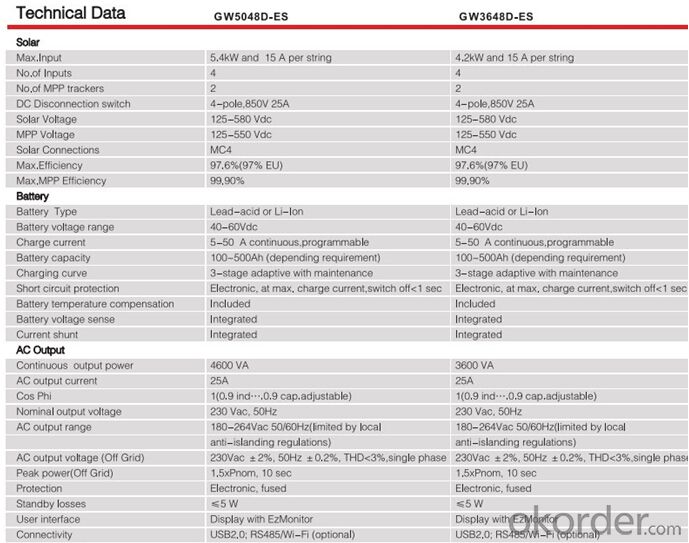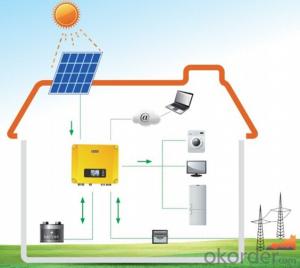Hybrid solar inverter GW5048D-ES
OKorder Service Pledge
OKorder Financial Service
You Might Also Like
GW5048D-ES series bidirectional energy-storage inverter is applicable for both on-grid and off-grid PV systems and can control the flow of energy hybrid with its working situation able to be switched automatically or manually. During the day time, the PV plant generates electricity which can be provided to the loads, fed into the grids or charged the battery. The power stored can be released when the loads require it during the night. Additionally, power grid can also charge the storage devices via the inverter..
Datasheet

- Q:What is the role of a grid protection relay in a solar inverter?
- The role of a grid protection relay in a solar inverter is to monitor the electrical grid and protect against any abnormalities or faults that may occur. It ensures the safe and reliable operation of the solar inverter by detecting and isolating faults such as overvoltage, undervoltage, overfrequency, underfrequency, and other grid disturbances. The grid protection relay acts as a safeguard, preventing any damage to the solar inverter and maintaining the stability of the grid connection.
- Q:What are the safety certifications to look for in a solar inverter?
- When looking for safety certifications in a solar inverter, some important ones to consider include the UL 1741 certification, which ensures compliance with safety standards for grid-connected inverters, and the IEC 62109 certification, which verifies the safety of the inverter in regards to electrical and fire hazards. Additionally, certifications such as CE, TÜV, and ETL mark can also indicate compliance with safety standards and regulations.
- Q:Are there any disadvantages of using a solar inverter?
- Yes, there are some disadvantages of using a solar inverter. One major disadvantage is the initial cost of purchasing and installing the inverter, which can be relatively high. Additionally, solar inverters are susceptible to damage from power surges or lightning strikes, which can result in costly repairs. Furthermore, solar inverters require regular maintenance to ensure optimal performance, which can add to the overall cost. Lastly, solar inverters can produce a humming noise during operation, which may be a nuisance in certain environments.
- Q:What is the maximum number of parallel inverters that can be installed in a solar system?
- The maximum number of parallel inverters that can be installed in a solar system depends on various factors such as the size and capacity of the solar system, the availability of space, and the electrical requirements of the installation. There is no fixed maximum number as it can vary significantly depending on these factors.
- Q:Are solar inverters weather-resistant?
- Yes, solar inverters are designed to be weather-resistant. They are typically built with durable materials and sealed enclosures to protect them from various weather conditions such as rain, snow, and extreme temperatures. However, it is always recommended to consult the manufacturer's specifications and guidelines to ensure proper installation and maintenance for optimal performance and longevity.
- Q:What is the maximum DC input voltage for a solar inverter?
- The maximum DC input voltage for a solar inverter typically depends on the specific model and manufacturer. However, in general, the maximum DC input voltage for most solar inverters is around 600 to 1000 volts. It is important to consult the product's specifications or contact the manufacturer to determine the exact maximum DC input voltage for a specific solar inverter model.
- Q:What is the role of a solar inverter in a solar-powered remote monitoring system?
- The role of a solar inverter in a solar-powered remote monitoring system is to convert the direct current (DC) electricity generated by the solar panels into alternating current (AC) electricity that can be used to power the monitoring system. It also ensures that the electricity generated matches the requirements of the monitoring equipment, regulates the voltage, and assists in efficient power transmission and distribution.
- Q:How do you calculate the maximum power point voltage for a solar inverter?
- To calculate the maximum power point voltage for a solar inverter, you need to determine the voltage at which the solar panels produce the maximum power output. This can be done by following the voltage-current (V-I) curve of the solar panels. By measuring the voltage and current at different points on the curve, you can identify the point where the product of voltage and current is the highest, indicating the maximum power point voltage.
- Q:Can a solar inverter be repaired or serviced?
- Yes, a solar inverter can be repaired or serviced. In case of a malfunction or damage, skilled technicians can diagnose and fix the issue, replace faulty components, or provide maintenance services to ensure optimal performance. It is recommended to consult with professionals or contact the manufacturer for assistance with repairs or servicing.
- Q:What is the standby power consumption of a solar inverter?
- The standby power consumption of a solar inverter refers to the amount of power it consumes when it is not actively converting solar energy into usable electricity. This power consumption is typically very low, often ranging from a few watts to a few tens of watts, depending on the model and efficiency of the inverter.
1. Manufacturer Overview |
|
|---|---|
| Location | |
| Year Established | |
| Annual Output Value | |
| Main Markets | |
| Company Certifications | |
2. Manufacturer Certificates |
|
|---|---|
| a) Certification Name | |
| Range | |
| Reference | |
| Validity Period | |
3. Manufacturer Capability |
|
|---|---|
| a)Trade Capacity | |
| Nearest Port | |
| Export Percentage | |
| No.of Employees in Trade Department | |
| Language Spoken: | |
| b)Factory Information | |
| Factory Size: | |
| No. of Production Lines | |
| Contract Manufacturing | |
| Product Price Range | |
Send your message to us
Hybrid solar inverter GW5048D-ES
OKorder Service Pledge
OKorder Financial Service
Similar products
New products
Hot products
Hot Searches
Related keywords





























